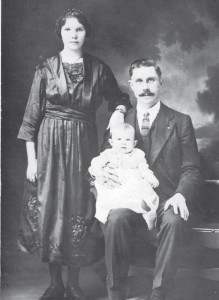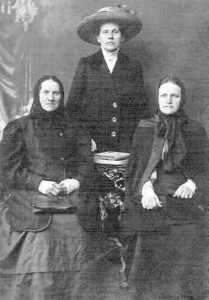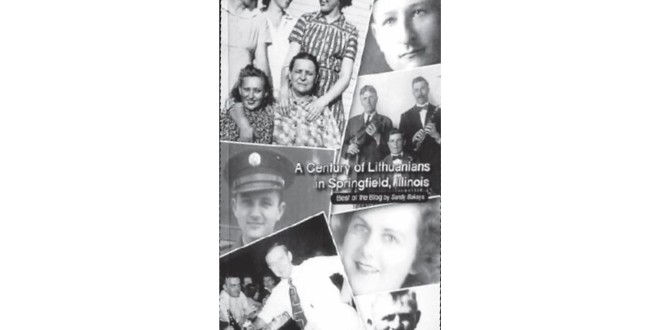By Sandy Baksys.
Sandy Baksys’ new book “A Century of Lithuanians in Springfield, Illinois” is an extensive collection of individual family stories providing a personalized record of the experiences shared by thousands of immigrants who came to United States in the previous century.
This is rediscovering of one’s roots on steroids. The 275 page book covers a broad historical swat and gives a human face to the early immigrant life. The book is based on a blog http://lithspringfield.com/ which the author maintained over a number of years. It is a compendium of individual human stories giving us a rare insight into not only the daily life Lithuanian immigrants but also the social conditions and issues which predominated at that time: the prominence of the local parish, the use of language, the labor movement, the war years. It reflects on the melding of two cultures — the Lithuanian and American producing a unique combination which is documented by Baksys. The book successfully combines two phenomena: numerous individuals with maintained family histories through albums, newspaper clippings and fond memories inserted into the high-speed world of the Internet. This combination gives new life to these memories now broadly shared in cyberspace.
We are thankful to the author for being a pioneer in this field. Hopefully others will follow suit and enshrine their own communities’ experiences. But with each passing year the memory fades, so there is an urgency to accomplish this. It is hoped this book will be a catalyst for others to follow on this quest. There is, after all, a tremendous saga to be recorded.
The author, Sandy Baksys, is a journalist and Lithuanian activist from Springfield, a coal mining community in Central Illinois. In 2012, she spearheaded the erection of a historical marker titled, “Lithuanians in Springfield,” and launched a blog that can be found at lithspringfield. com. The blog has been a resounding success, encouraging many Springfielders and their descendants to share with Baksys their own stories and photographs. Baksys is especially qualified for this job as chronicler of the past. She has worked as newspaper reporter, medical trade journalist, and for the last 19 years, a public relations consultant and writer. She holds a bachelor’s degree in journalism from Northwestern University, as well as a B.A. in Italian and an M.A. in English literature from the University of Kentucky.
In this interview, she shares her passion for the Lithuanian community of Springfield as well as the trials and joys of book publishing. A Century of Lithuanians in Springfield Illinois by Sandy Baksys is available from Amazon.com


You grew up in Springfield, Illinois as the daughter of a Lithuanian immigrant who came to the United States due to the upheavals of the Second World War. Why did your father settle in Springfield? Were there many Lithuanians living there who were a part of that post-war immigrant wave?
My father’s name was recognized by his paternal great aunt Mary Yamont (Jomantiene) on a list of DPs published in a Lithuanian paper after WWII. Mary Yamont had settled in Springfield with her coal-miner husband after the couple met and married in Scranton, PA, sometime before WWI. She sponsored my dad to come live with her and her two adult sons and daughter in a three-room house in “Little Lithuania” near the Illinois State Fairgrounds, and also found Dad the pledge of a job. Due to the crowded living conditions, my father did not stay at his aunt’s house long, but he always remembered and honored his aunt for helping him—maybe also because she was the only family member senior to him in the U.S.
When we were young, Dad took us to visit “Teta” most Sundays, and she was like our grandmother even though she spoke very little English and we spoke no Lithuanian. I don’t have an exact count, but my feeling is that Dad was among something less than two-dozen individuals/ families from the second wave who settled in Springfield.
The first wave was much larger here—2,000-3,000 Lithuanian immigrants to the area drawn by potential work in the dozens of coal mines in operation here around the turn of the 20-th century. Sometimes I also think of the first-wave Lithuanian who came here as a kind of human spillover from the already saturated Pennsylvania mining labor market.
There’s so much interesting information here. How long have you been gathering material?
I started writing stories for my blog during the summer of 2012, after finishing my historical marker project with the Illinois State Historical Society. I wanted to see if I could use family histories to re-ignite Lithuanian ethnic interest and re-connect people both online and “on the ground” to re-grow Springfield’s shrinking Lithuanian- American Club. People younger than 50 not needing to accompany an elderly parent almost never showed up, and we had gotten down to only about 35 participants at our annual picnic, potluck and Christmas party.
Can a book really change all that?
It remains to be seen how much of a grassroots organizing impact somebody can have by researching, writing, and selling a book like mine. But it’s clear that in the old coal-mining communities where the first wave settled and there have been few or no new immigrants since the second wave, Lithuanian identity is today largely a matter of history. So why not try to re-connect people to that history, while re-connecting them to each other through a new awareness of history?
I can tell you that people I’ve met and introduced to each other through my research or through publicizing my blog posts have become a community of sorts that did not previously exist. Reviving Lithuanian history on this personal level, with local faces and stories, may seem very small-scale, but the personal level is where people live and breathe.
So maybe the question is not how modestly galvanizing the impact of something like this can be on reviving Lithuanian identity where that identity has been lost. In many communities without fresh Lithuanian immigrants and identity, retrieving and sharing our common ethnic history may be the only option we have left.
Because Lithuania lives in a dangerous neighborhood, it will always need as many friends and as much positive awareness as it can get in the United States. For that reason, we can’t afford to lose the next generations of the first and second waves—at least not without trying to use the best tools for reviving identity that we have left.
Which brings us to my ulterior-ulterior motive, beyond writing and selling a great book. After I bring more people back into the Lithuanian fold, connect them a little more to “the old country” and update them on current events—after I bring them to a high enough level of interest or a feeling of having more of a stake—my plan is to eventually operate an informal network to lobby U.S. political leaders to help Lithuania. It may be another smallish project, but it will be what I—what we—can do. And doing what you can do is what’s most important.
How did you come by the stories in your book?
I came by my stories in so many different ways. Sometimes a fact or loose end in one tale would lead to another. Some seeds for chapters were provided by my volunteer researchers William Cellini, Jr., of Chicago and Tom Mann of Springfield in the form of genealogy research or archived newspaper features. I enjoyed processing their leads and making over-arching connections between raw information, finding holes that needed to be filled and piecing together the puzzle, so to speak. That is how I conceive of the responsibility of writing—of being a writer on a project like this.
There were also many chapters I originated, researched, and wrote because I knew where to look and I had made the decision to try to cover all the critical bases in the story of our local Lithuanians. The best example of that is my Knights of Lithuania chapter, which really opened my eyes about the level of Lithuanian activity here in the 1920s.

One of my favorite things about the process of the book is how pieces fell into place once I reached a critical mass. Literally while the train was leaving the station this past summer and I was editing the book chapter by chapter and sending the chapters chronologically to design, I was contacted out of the blue by someone with the story of the local Lithuanian leftists I knew had existed, but which no previous source claimed to know anything about. Key facts for my Lithuanian Women in Marriage and Divorce chapter emerged with the same serendipity near the very end of the process, after I had been pressing a family for some time for their photos and story. And now I can’t imagine the book without either of those chapters.
Did writing the book surprise or change you in any way? What is the most important thing you learned?
One thing that occurred to me about the book only after I finished it was that everything I had discovered, and taught myself, over the space of three years was probably less than the sum of what our first-wave elders and their children knew just from living their daily lives here in Springfield. But that’s why they never sat down and wrote it—they already knew it. My book truly was a voyage of discovery that was made necessary by all I didn’t know. I used writing to teach myself, and hopefully, my readers.
I deliberately was not writing an autobiography or memoir because I chose to write and illustrate other families’ stories. However, all along the way, writing the book gave me reflections I would not otherwise have had and provided sudden, intuitive insights into events in the lives of my father, my aunts and uncles, my grandparents. Many, many times, I made sudden, intuitive connections that filled holes in my own family’s story with facts from those of the families I was writing about, or gave new emphasis to parts of my own family’s story. By looking back through other family histories interpretively, I came to new “facts,” new realizations, such as the high possibility that the lethality of the pneumonia that killed my paternal grandfather in his 40s was likely due to miner’s black lung disease. Writing so much about Lithuanian illiteracy in the first wave, and what was said about President Smetona when he visited here, gave new historical dimensions to my father’s three years of formal education back in the 1930s.
Of course the most important personal discovery for me was the other surviving branch of my paternal grandfather’s family here in Springfield (the Orbacks) that had not been revealed to my sisters and me as we were introduced to the Yamont branch (that had sponsored our dad). Ties to that branch had been totally lost.
Do you have a favorite story from the book?
I think I enjoyed writing about Joey (Jonaitis) Mack, the vaudeville comedy dance man, the most because he was a blind find suggested to me by a blog reader. I also had more fun playing with language and sentence structure in the Joey Mack story. And then to realize that he was behind the Mack School of Dance where my mother first took me to have dance lessons!
I also enjoyed the outlaw and outliers stories in the book, since none of us was ever raised to acknowledge any kind of Lithuanian-American social dysfunction or criminality. It was all such a surprise, including the criminal histories I discovered about two of Dad’s first cousins born in America, which the family hid from us, along with those cousins. I now better understand the fierce and almost defensive pride Dad at times manifested about just making it on the straight and narrow in America, going to work and raising a family, which seemed pretty small potatoes to a girl raised to have big ambitions by those, like Teta, whose lives didn’t afford many.
One of the aspects of the book I like most is its tone. You include information about yourself here and there in a very natural, unobtrusive way. Would you consider this work part memoir?
Yes. From the beginning, the blog format allowed the stories I wrote obliquely or episodically to include elements of memoir. Blogs are first-person, after all. However selective inclusion of personal notes and reflections followed my decision, at the outset, to stand the whole blog format on its head by writing exclusively about other people’s families. Despite that decision, it remained possible to use anecdotes and facts from my family story when relevant to illuminate the stories of others or back up an interpretive point I was trying to make. So I had the best of both worlds.
What’s on the horizon in terms of a second book or project?
I’m resting now—resting and selling books and getting back to my day job in public relations consulting from a home office. I’ve got some serious lost income to make up. My lifelong dream has been to find my voice in fiction and poetry. However, I believe it was a writer from Lincoln, IL, who once worked as an editor at The New Yorker, who said that nothing one writes, whether in biography or autobiography, can be exactly as it happened. So, maybe I have fulfilled my dream to write a creative, literary work after all. As for what’s next, at this age, I will take whatever assignment the muse serves up. Although my “neglected” husband says next time I have to ask his permission before I start.
 DRAUGAS NEWS Lithuanian World Wide News in English
DRAUGAS NEWS Lithuanian World Wide News in English
